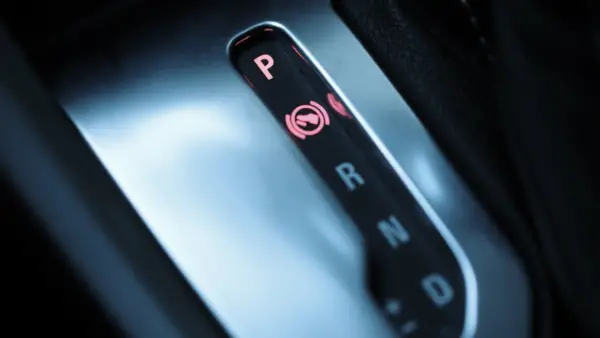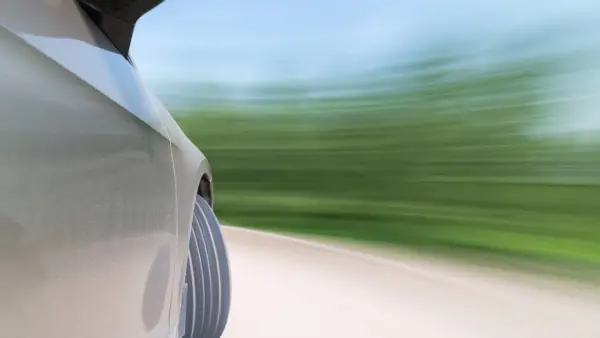Always Leave Your Car In a Gear
Have you ever wondered about parking your car in gear? Always leave your car in a gear (if standard) or in ‘P’ (Park if automatic).
Why? It will hold the vehicle in place & keep it from rolling away. This can happen if the emergency or parking brake were to fail. This is a real thing that happens sometimes. For a related article, check out Right-of-Way in the Parking Lot.
How to park an automatic car

Leave the automatic vehicle in park, with the parking brake applied, every time you park.
The best way to park your automatic car is to:
- First, put the vehicle into neutral, and then apply the parking brake
- Then, slowly ease off the brake pedal until your foot is completely off the pedal
- Then you know 100% that the parking brake is holding the car in place. This is like a little test to make sure.
- Then put the vehicle into “park”
If you slowly remove your foot from the pedal while the parking brake is applied, and the vehicle begins to move or roll slightly, then it has failed your test.
You will know that the parking brake is not actually doing anything useful, even though it may be applied.
What’s The Point Of Using It If It’s Actually Not Doing Anything?

If this happens, you have to fix it.
- You must either press the foot parking brake harder
- Or pull the hand brake up higher until you’re sure the brake is actually holding the vehicle in place
You can apply your parking brake with varying degrees
Don’t apply it with too much pressure. This can stretch your parking brake cable. It’s extra, unnecessary wear and tears. Someone may need to service your brake system. Do remember that parking brakes exist to do a job.
When you’re satisfied the car is not moving while in neutral with the parking brake applied, put your foot back onto the brake pedal and place the transmission into park.
This way, you know that the parking brake is 100% the first thing keeping the car from moving.
Parking Your Car In Gear – If The Parking Brake Fails

If the parking brake fails, the transmission or Parking gear will keep the vehicle from moving. This is a kind of a backup plan.
You can see for yourself by simply removing the parking brake after this procedure. You will be able to feel the vehicle move a bit before the gear holds it in place.
It is better to ensure the vehicle is being held in place by the parking brake. This is the purpose of the parking brake.

Parking Your Car In Gear – Parking Brake As Emergency Brake
You can also use your parking brake as an emergency brake. If your service brakes (brake pedal) were to fail, you can use the parking brake to help stop or slow the car.
If you simply put the car in Park without the parking brake, this will hold the car in place most likely. However, this can cause wear and wear on the pin on the transmission. It may need mechanical repairs/servicing over time.
If your transmission pin fails, and your emergency/parking brake was not applied, then your car would simply be free to basically roll away
- Your car would freely roll away until it runs into something, according to gravity.
- You will be able to feel a clunk when you move from Park into Drive if your vehicle has been parked; especially on a hill without the parking brake.
- I’m not a mechanic, but it seems better if you can avoid any clunking of your transmission components.

Parking Your Car in Gear – Standard Cars

Parking Your Car In Gear – Always Leave Your Standard Car In A Gear When Parked
If the parking brake were to fail, the gear would hold the car in place as a backup.
- If you simply park with the parking brake on and the transmission in neutral, and the parking brake was to fail, the car may end up simply rolling down the road.
- It would keep rolling as per gravity and may run into something, or worse – someone.
- Your car might roll away, too, if something or someone were to hit your car when it was parked.
Parking Your Car In Gear – The Procedure
- First, set the wheels if parking on a hill.
The reason to do this step first is so that you can avoid dry steering That is, steering when the car is not moving.
See this article on how to park on hills
- Basically, if you’re parking facing down a hill on the right side of the road, turn the wheels to the right all the way.
- If you’re parking on an uphill with a curb, turn the wheel left all the way.
- If you’re parking on an uphill without a curb, turn the wheels to the right all the way.
- Second, apply the parking brake. Then, in neutral, slowly remove your foot from the brake pedal. This is to ensure the parking brake is actually holding the car in place.

What’s The Point In Using It If You Don’t Know It’s Actually Going To Do Its Job?
Some people may not apply the brake enough, making it essentially useless. Third, turn off the car.

Parking Your Car In Gear – Parking Down A Hill
If you’re parking your car on a downhill, leave your car in reverse gear. This is so that you are leaving the car to work against gravity.
Parking Up a Hill
- If you’re parking on an uphill, leave your car in 1st gear. Again, this is so that you’re leaving it against gravity.
- Your car – left to work against gravity – is far less likely to roll away.
Parking On a Flat Surface

I would usually recommend leaving it in 1st gear for parking on flat surfaces. I am not sure it matters a lot, although leaving it in any gear is better than leaving it not in any gear.
To see what I mean, you could then remove the parking brake and feel how the car is being held in place by the gear.
- Preferably, the parking brake is the thing holding the car in place.
- The parking brake is usually a brake cable connected to the rear tires, designed for such a thing.
- The gear is a backup plan.
- People designed transmissions to change gears, not to hold thousands of pounds in place on a hill.
- The pin on the transmission holding the gear in place could potentially fail after time goes by. If this happens, it may likely slip into neutral.
- Your car may roll away if your parking brake has not been applied and checked for proper function.
- Using these techniques will ensure your vehicle never “rolls away without you.”
- Cars do not start rolling away often, but it does happen from time to time and it is much better to be safe than sorry.
Drivers in British Columbia are legally required to turn the wheels appropriately when parked on a hill.
BMW Rolls Away On Its Own, Twice
Okay, so maybe in the BMW case the vehicle was defective and subject to a recall.
But keep in mind all vehicles are mechanical things, which could fail; especially with time.
CHECK OUT THE BMW ROLLING AWAY BY ITSELF
Gear For Turning Corners

While we’re on the subject, let’s talk about turning corners.
- For turning a 90-degree typical corner – if you’re simply turning without stopping – generally you should use 2nd gear.
- 3rd is a bit high and may lug the engine and/or lack torque/power.
- People rarely use 1st gear for turning.
- But, it may be appropriate if you’ve stopped completely. Or, if you are traveling very slowly before being able to proceed.
Conclusion
No matter what kind of vehicle you drive, you should always leave your vehicle in “park” or in gear if it’s a standard. Cars can – and do – start rolling away without drivers in them when mechanical problems occur, or when people have forgotten to properly park their car.
You can follow a procedure to ensure that your car will never roll away without you. Especially when you park on a hill, you can turn your wheels to ensure the least amount of impact and/or damage, even if it does roll.
Gears have their purpose, but when parking they can and should be used as a backup plan in case your parking brake aka emergency brake fails or has a problem. The “park” or any forward or reverse gear on a standard should keep the car in place. Following these procedures will ensure you can always find your car where you left it, which is always a fancy feeling. Preparing for your ICBC road test? Be sure to check out my epic article: ICBC Road Test Tips For Classes 5 & 7 [Instructor Gets Deep].
Related:

A woman was driving across the white lines in a parking lot not bothering to use the lane that was…